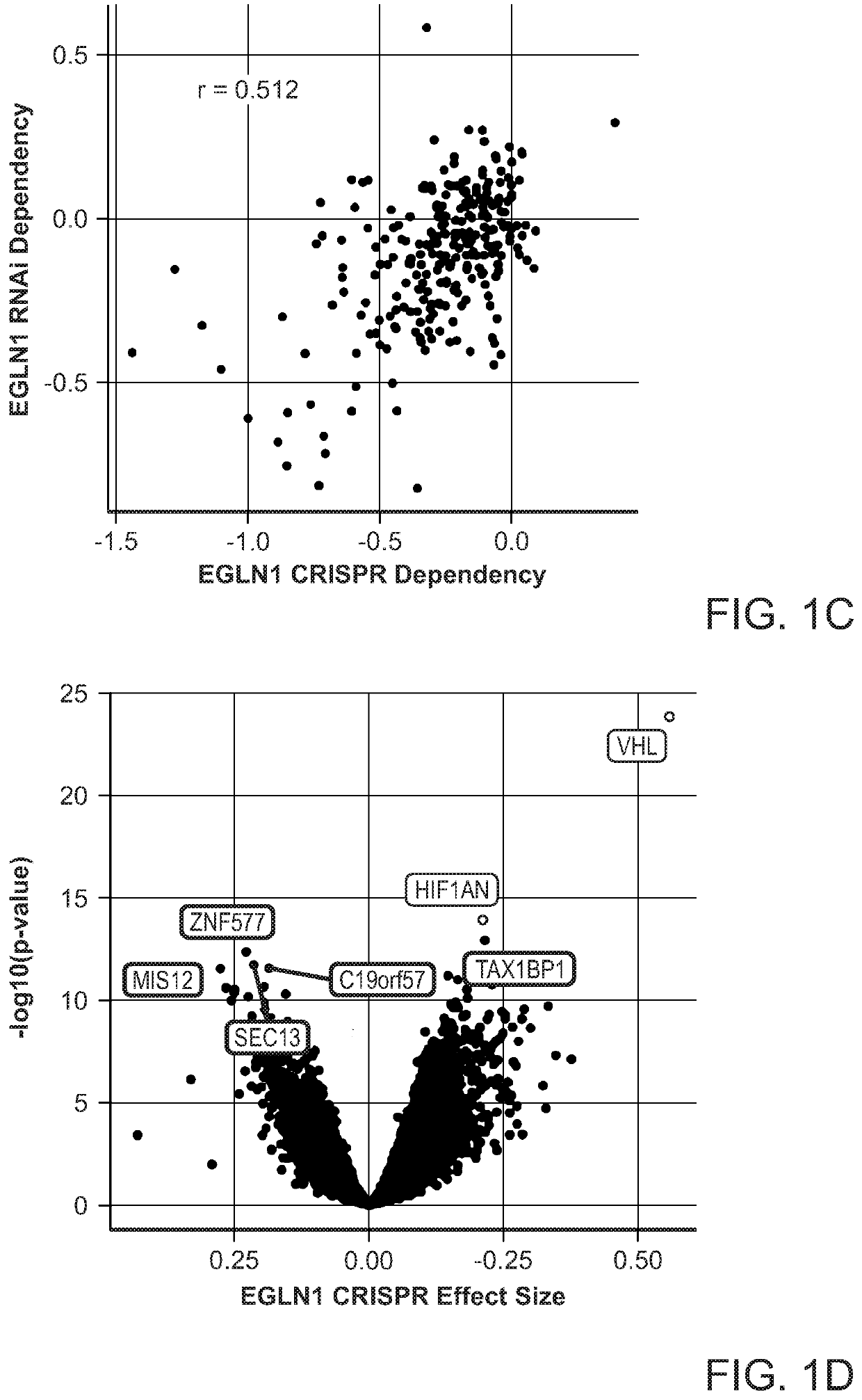Targeting egln1 in cancer
a cancer and egln1 technology, applied in the field of cancer egln1 targeting, can solve the problems of ongoing challenge in maintenance, achieve the effect of reducing or avoiding symptoms, signs or causes of the condition, and reducing or minimizing one or more symptoms
- Summary
- Abstract
- Description
- Claims
- Application Information
AI Technical Summary
Benefits of technology
Problems solved by technology
Method used
Image
Examples
example 1
and Methods
Analysis of Dependency Data
[0203]Gene dependency data from Project Achilles, including data from the screening of 501 cancer cell lines by RNAi (˜94k shRNAs, ˜5 shRNAs / gene) and 436 cancer cell lines with CRISPR-Cas9 (˜70k sgRNAs, ˜4 sgRNAs / gene) (1-5). EGLN1 was originally identified as an interesting target to pursue using the DEMETER six sigma dependencies (2). Further analyses were performed using DEMETER2 RNAi (20, 54) and CERES CRISPR / Cas9 dependency data (7, 19, 54, 55). All significant findings have been summarized in the supplemental tables.
Identifying Features Associated with EGLN1 Dependency
[0204]Multiple approaches were employed to find relationships between EGLN1 dependency and mRNA expression, copy-number, mutation, or dependency data (see below “CCLE Omics Data” section for details). To identify genes whose mutation was associated with EGLN1 dependency, two-sample t-tests were used to measure the mean-difference of dependency between mutant and WT cell line...
example 2
de Interrogation of Human Cancers Identified EGLN1 as a Druggable Preferential Dependency, in Clear Cell Ovarian Cancers and Melanoma
[0228]Genes that are essential for cell viability in a context-specific manner, in contrast to pan-essential genes, represent potential cancer dependencies. To identify such genes, genome-scale loss-of-function screens were performed using RNAi and CRISPR-Cas9 technologies in hundreds of human cancer cell lines (2, 3, 5). Data derived from screening 501 human cancer cell lines with RNAi were analyzed, and 762 genes were identified that were essential for the proliferation / survival of a subset of cell lines at a level of 6 standard deviations from the mean dependency score; a stringent metric to find such differential dependencies (2, 3, 5). Of these 762 genes, 153 of them were found to be classified as druggable based on previous annotations (2) (FIG. 1A, Supplementary Table 2)(2). Among the druggable genes, 15 were targets of molecules that are either...
example 3
endency was Enriched in Ovarian Clear Cell Carcinoma and Melanoma
[0233]To investigate whether EGLN1 dependency was enriched in specific cancer types, a lineage enrichment analysis was performed using the Fisher's exact test. Such analysis identified that melanoma and ovarian cancer cell lines were significantly enriched for EGLN1 dependencies in the CRISPR-Cas9 and RNAi datasets (FIG. 9A, FDR<0.1). Specifically, among the ovarian cancer cell lines, 13 of 33 (39%) ovarian cancer cell lines were dependent on EGLN1 (FIGS. 2A and 2B). Similarly, these cell lines were also found to be dependent on EGLN1 in the RNAi dataset, and cell lines in both datasets showed strongly correlated EGLN1 dependencies (FIG. 9C). Because ovarian cancer represents a heterogeneous disease comprised of four major different subtypes (23-33), EGLN1 dependency was examined in individual subtypes. To determine whether EGLN1 dependency was enriched in a specific subtype, the ovarian cancer cell lines were grouped ...
PUM
| Property | Measurement | Unit |
|---|---|---|
| diameter | aaaaa | aaaaa |
| diameter | aaaaa | aaaaa |
| diameter | aaaaa | aaaaa |
Abstract
Description
Claims
Application Information
 Login to View More
Login to View More - R&D
- Intellectual Property
- Life Sciences
- Materials
- Tech Scout
- Unparalleled Data Quality
- Higher Quality Content
- 60% Fewer Hallucinations
Browse by: Latest US Patents, China's latest patents, Technical Efficacy Thesaurus, Application Domain, Technology Topic, Popular Technical Reports.
© 2025 PatSnap. All rights reserved.Legal|Privacy policy|Modern Slavery Act Transparency Statement|Sitemap|About US| Contact US: help@patsnap.com



